Satellite-Based Distribution of Inverse Altitude Effect of Global Water Vapor Isotopes: Potential Influences on Isotopes in Climate Proxies
Abstract
1. Introduction
2. Materials and Methods
2.1. Materials
2.2. Methods
2.2.1. Determination of IAE Frequency
2.2.2. Simulated Precipitation Isotopes
3. Results
3.1. Annual Characteristics of IAE in Water Vapor
3.2. Seasonal Characteristics of IAE in Water Vapor
4. Discussion
4.1. Impact of Errors on IAE
4.2. Implications of Isotope Paleoaltimetry
5. Conclusions
Supplementary Materials
Author Contributions
Funding
Data Availability Statement
Acknowledgments
Conflicts of Interest
References
- Brenner, A.; Fu, R.; Evans, D.; Smirnov, A.; Trubko, R.; Rose, I. Paleomagnetic evidence for modern-like plate motion velocities at 3.2 Ga. Sci. Adv. 2020, 6, eaaz8670. [Google Scholar] [CrossRef] [PubMed]
- Lippert, P.; Zhao, X.; Coe, R.; Lo, C. Palaeomagnetism and 40Ar/39Ar geochronology of upper Palaeogene volcanic rocks from central Tibet: Implications for the central Asia inclination anomaly, the palaeolatitude of Tibet and post-50 Ma shortening within Asia. Geophys. J. Int. 2011, 184, 131–161. [Google Scholar] [CrossRef]
- Li, J.; Song, X. Tearing of Indian mantle lithosphere from high-resolution seismic images and its implications for lithosphere coupling in southern Tibet. Proc. Natl. Acad. Sci. USA 2018, 115, 8296–8300. [Google Scholar] [CrossRef] [PubMed]
- Xiong, Z.; Liu, X.; Ding, L.; Farnsworth, A.; Spicer, R.; Xu, Q.; Valdes, P.; He, S.; Zeng, D.; Wang, C.; et al. The rise and demise of the Paleogene central Tibetan valley. Sci. Adv. 2022, 8, eabj0944. [Google Scholar] [CrossRef] [PubMed]
- Jellinek, A.; Lenardic, A.; Pierrehumbert, R. Ice, fire, or fizzle: The climate footprint of Earth’s supercontinental cycles. Geochem. Geophys. Geosyst. 2020, 21, e2019GC008464. [Google Scholar] [CrossRef]
- Farnsworth, A.; Lunt, D.; Robinson, S.; Valdes, P.; Roberts, W.; Clift, P.; Markwick, P.; Su, T.; Wrobel, N.; Bragg, F.; et al. Past East Asian monsoon evolution controlled by paleogeography, not CO2. Sci. Adv. 2019, 5, eaax1697. [Google Scholar] [CrossRef]
- Farnsworth, A.; Valdes, P.; Spicer, R.; Ding, L.; Witkowski, C.; Lauretano, V.; Su, T.; Li, S.; Li, S.; Zhou, Z. Paleoclimate model-derived thermal lapse rates: Towards increasing precision in paleoaltimetry studies. Earth Planet. Sci. Lett. 2021, 564, 116903. [Google Scholar] [CrossRef]
- Meyer, H. A review of paleotemperature–lapse rate methods for estimating paleoelevation from fossil floras. Rev. Mineral. Geochem. 2007, 66, 155–171. [Google Scholar] [CrossRef]
- Spicer, R.; Su, T.; Valdes, P.; Farnsworth, A.; Wu, F.; Shi, G.; Spicer, T.; Zhou, Z. The topographic evolution of the Tibetan region as revealed by palaeontology. Palaeobio. Palaeoenv. 2021, 101, 213–243. [Google Scholar] [CrossRef]
- Botsyun, S.; Sepulchre, P.; Donnadieu, Y.; Risi, C.; Licht, A.; Rugenstein, J. Revised paleoaltimetry data show low Tibetan Plateau elevation during the Eocene. Science 2019, 363, eaaq1436. [Google Scholar] [CrossRef]
- Dar, T.; Rai, N.; Bhat, M.A.; Kumar, S.; Jahan, A. Surface water isoscape modeling in the Himalayan region: An alternative for moisture source investigation, hydrograph separation, and paleolatitude estimation. Water Resour. Res. 2023, 59, e2022WR033572. [Google Scholar] [CrossRef]
- Farnsworth, A.; Valdes, P.; Ding, L.; Spicer, R.; Li, S.; Su, T.; Li, S.; Witkowski, C.; Xiong, Z. Limits of oxygen isotope palaeoaltimetry in Tibet. Earth Planet. Sci. Lett. 2023, 606, 118040. [Google Scholar] [CrossRef]
- Tripti, M.; Lambs, L.; Moussa, I.; Corenblit, D. Evidence of elevation effect on stable isotopes of water along highlands of a humid tropical mountain belt (Western Ghats, India) experiencing monsoonal climate. J. Hydrol. 2019, 573, 469–485. [Google Scholar] [CrossRef]
- Jiao, Y.; Liu, C.; Gao, X.; Xu, Q.; Ding, Y.; Liu, Z. Impacts of moisture sources on the isotopic inverse altitude effect and amount of precipitation in the Hani Rice Terraces region of the Ailao Mountains. Sci. Total Environ. 2019, 687, 470–478. [Google Scholar] [CrossRef]
- Jing, Z.; Yu, W.; Lewis, S.; Thompson, L.; Xu, J.; Zhang, J.; Xu, B.; Wu, G.; Ma, Y.; Wang, Y.; et al. Inverse altitude effect disputes the theoretical foundation of stable isotope paleoaltimetry. Nat. Commun. 2022, 13, 4371. [Google Scholar] [CrossRef]
- Deng, T.; Ding, L. Paleoaltimetry reconstructions of the Tibetan Plateau: Progress and contradictions. Natl. Sci. Rev. 2015, 2, 417–437. [Google Scholar] [CrossRef]
- Hoke, G. Geochronology transforms our view of how Tibet’s southeast margin evolved. Geology 2018, 46, 95–96. [Google Scholar] [CrossRef]
- Moore, M.; Kuang, Z.; Blossey, P. A moisture budget perspective of the amount effect. Geophys. Res. Lett. 2014, 41, 1329–1335. [Google Scholar] [CrossRef]
- Shen, H.; Poulsen, C. Precipitation δ18O on the Himalaya–Tibet orogeny and its relationship to surface elevation. Clim. Past 2019, 15, 169–187. [Google Scholar] [CrossRef]
- Spicer, R.; Su, T.; Valdes, P.; Farnsworth, A.; Wu, F.; Shi, G.; Spicer, T.; Zhou, Z. Why ‘the uplift of the Tibetan Plateau’ is a myth. Natl. Sci. Rev. 2021, 8, nwaa091. [Google Scholar] [CrossRef]
- Kong, Y.; Pang, Z. A positive altitude gradient of isotopes in the precipitation over the Tianshan Mountains: Effects of moisture recycling and sub-cloud evaporation. J. Hydrol. 2016, 542, 222–230. [Google Scholar] [CrossRef]
- Sodemann, H.; Aemisegger, F.; Pfahl, S.; Bitter, M.; Corsmeier, U.; Feuerle, T.; Graf, P.; Hankers, R.; Hsiao, G.; Schulz, H.; et al. The stable isotopic composition of water vapor above Corsica during the HyMeX SOP1 campaign: Insight into vertical mixing processes from lower-tropospheric survey flights. Atmos. Chem. Phys. 2017, 17, 6125–6151. [Google Scholar] [CrossRef]
- Galewsky, J. Using stable isotopes in water vapor to diagnose relationships between lower-tropospheric stability, mixing, and low-cloud cover near the island of Hawaii. Geophys. Res. Lett. 2018, 45, 297–305. [Google Scholar] [CrossRef]
- Thurnherr, I.; Kozachek, A.; Graf, P.; Weng, Y.; Bolshiyanov, D.; Landwehr, S.; Pfahl, S.; Schmale, J.; Sodemann, H.; Steen-Larsen, H.; et al. Meridional and vertical variations of the water vapor isotopic composition in the marine boundary layer over the Atlantic and Southern Ocean. Atmos. Chem. Phys. 2020, 20, 5811–5835. [Google Scholar] [CrossRef]
- Worden, J.; Bowman, K.; Noone, D.; Beer, R.; Clough, S.; Eldering, A.; Fisher, B.; Goldman, A.; Gunson, M.; Herman, R.; et al. Tropospheric Emission Spectrometer observations of the tropospheric HDO/H2O ratio: Estimation approach and characterization. J. Geophys. Res. 2006, 111, D16309. [Google Scholar] [CrossRef]
- Worden, J.; Noone, D.; Bowman, K. Importance of rain evaporation and continental convection in the tropical water cycle. Nature 2007, 445, 528–532. [Google Scholar] [CrossRef] [PubMed]
- Risi, C.; Bony, S.; Vimeux, F.; Frankenberg, C.; Noone, D.; Worden, J. Understanding the Sahelian water budget through the isotopic composition of water vapor and precipitation. J. Geophys. Res. Atmos. 2010, 115, D24110. [Google Scholar] [CrossRef]
- Risi, C.; Landais, A.; Winkler, R.; Vimeux, F. Can we determine what controls the spatiotemporal distribution of d-excess and 17O-excess in precipitation using the LMDZ general circulation model? Clim. Past 2013, 9, 2173–2193. [Google Scholar] [CrossRef]
- Lacour, J.; Flamant, C.; Risi, C.; Clerbaux, C.; Coheur, P. Importance of the Saharan heat low in controlling the North Atlantic free tropospheric humidity budget deduced from IASI δD observations. Atmos. Chem. Phys. 2017, 17, 9645–9663. [Google Scholar] [CrossRef]
- Lacour, J.; Risi, C.; Worden, J.; Clerbaux, C.; Coheur, P. Importance of depth and intensity of convection on the isotopic composition of water vapor as seen from IASI and TES δD observations. Earth Planet. Sci. Lett. 2018, 481, 387–394. [Google Scholar] [CrossRef]
- Toride, K.; Yoshimura, K.; Tada, M.; Diekmann, C.; Ertl, B.; Khosrawi, F.; Schneider, M. Potential of mid-tropospheric water vapor isotopes to improve large-scale circulation and weather predictability. Geophys. Res. Lett. 2021, 48, e2020GL091698. [Google Scholar] [CrossRef]
- Bonne, J.; Steen-Larsen, H.; Risi, C.; Werner, M.; Sodemann, H.; Lacour, J.; Fettweis, X.; Cesana, G.; Delmotte, M.; Cattani, O.; et al. The summer 2012 Greenland heat wave: In situ and remote sensing observations of water vapor isotopic composition during an atmospheric river event. J. Geophys. Res. Atmos. 2015, 120, 2970–2989. [Google Scholar] [CrossRef]
- Tuinenburg, O.; Risi, C.; Lacour, J.; Schneider, M.; Wiegele, A.; Worden, J.; Kurita, N.; Duvel, J.; Deutscher, N.; Bony, S.; et al. Moist processes during MJO events as diagnosed from water isotopic measurements from the IASI satellite. J. Geophys. Res. Atmos. 2015, 120, 10619–10636. [Google Scholar] [CrossRef]
- Lacour, J.; Clarisse, L.; Worden, J.; Schneider, M.; Barthlott, S.; Hase, F.; Risi, C.; Clerbaux, C.; Hurtmans, D.; Coheur, P. Cross-validation of IASI/MetOp derived tropospheric δD with TES and ground-based FTIR observations. Atmos. Meas. Tech. 2015, 8, 1447–1466. [Google Scholar] [CrossRef]
- Diekmann, C.; Schneider, M.; Ertl, B.; Hase, F.; Garcia, O.; Khosrawi, F.; Sepulveda, E.; Knippertz, P.; Braesicke, P. The global and multi-annual MUSICA IASI {H2O, δD} pair dataset. Earth Syst. Sci. Data 2021, 13, 5273–5292. [Google Scholar] [CrossRef]
- Lacour, J.; Risi, C.; Clarisse, L.; Bony, S.; Hurtmans, D.; Clerbaux, C.; Coheur, P. Mid-tropospheric δD observations from IASI/MetOp at high spatial and temporal resolution. Atmos. Chem. Phys. 2012, 12, 10817–10832. [Google Scholar] [CrossRef]
- Clerbaux, C.; Boynard, A.; Clarisse, L.; George, M.; Hadji-Lazaro, J.; Herbin, H.; Hurtmans, D.; Pommier, M.; Razavi, A.; Turquety, S.; et al. Monitoring of atmospheric composition using the thermal infrared IASI/MetOp sounder. Atmos. Chem. Phys. 2009, 9, 6041–6054. [Google Scholar] [CrossRef]
- Diekmann, C.J.; Schneider, M.; Ertl, B. Regular 1° × 1° Re-Gridded MUSICA IASI Water Isotopologue Pair Dataset (a Posteriori Processing Version 2); Institute of Meteorology and Climate Research, Atmospheric Trace Gases and Remote Sensing (IMK-ASF), Karlsruhe Institute of Technology (KIT): Karlsruhe, Germany, 2021. [Google Scholar] [CrossRef]
- Schneider, M.; Hase, F.; Blumenstock, T. Ground-based remote sensing of HDO/H2O ratio profiles: Introduction and validation of an innovative retrieval approach, Atmos. Chem. Phys. 2006, 6, 4705–4722. [Google Scholar] [CrossRef]
- Schneider, M.; González, Y.; Dyroff, C.; Christner, E.; Wiegele, A.; Barthlott, S.; García, O.; Sepúlveda, E.; Hase, F.; Andrey, J.; et al. Empirical validation and proof of added value of MUSICA’s tropospheric δD remote sensing products. Atmos. Meas. Tech. 2015, 8, 483–503. [Google Scholar] [CrossRef][Green Version]
- Horita, J.; Wesolowski, D. Liquid-vapor fractionation of oxygen and hydrogen isotopes of water from the freezing to the critical temperature. Geochim. Cosmochim. Acta 1994, 58, 3425–3437. [Google Scholar] [CrossRef]
- Araguás-Araguás, L.; Froehlich, K.; Rozanski, K. Deuterium and oxygen-18 isotope composition of precipitation and atmospheric moisture. Hydrol. Process. 2000, 14, 1341–1355. [Google Scholar] [CrossRef]
- Bowen, G.; Wilkinson, B. Spatial distribution of δ18O in meteoric precipitation. Geology 2002, 30, 315–318. [Google Scholar] [CrossRef]
- Wang, L.; Wang, S.; Zhang, M.; Duan, L.; Xia, Y. An hourly-scale assessment of sub-cloud evaporation effect on precipitation isotopes in a rainshadow oasis of northwest China. Atmos. Res. 2022, 274, 106202. [Google Scholar] [CrossRef]
- Yin, J.; Guo, S.; Wang, J.; Chen, J.; Zhang, Q.; Gu, L.; Yang, Y.; Tian, J.; Xiong, L.; Zhang, Y. Thermodynamic driving mechanisms for the formation of global precipitation extremes and ecohydrological effects. Sci. China Earth Sci. 2023, 66, 92–110. [Google Scholar] [CrossRef]
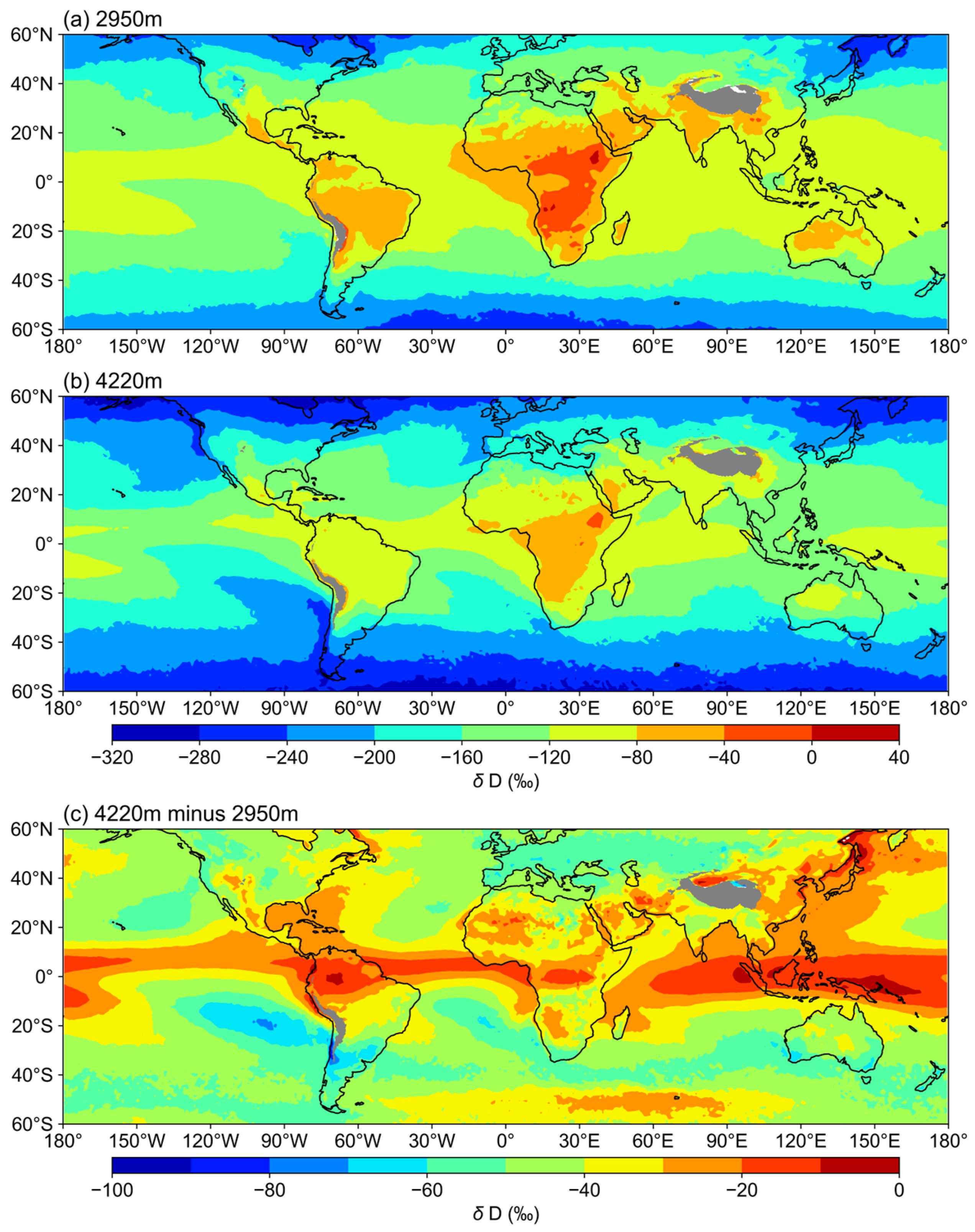

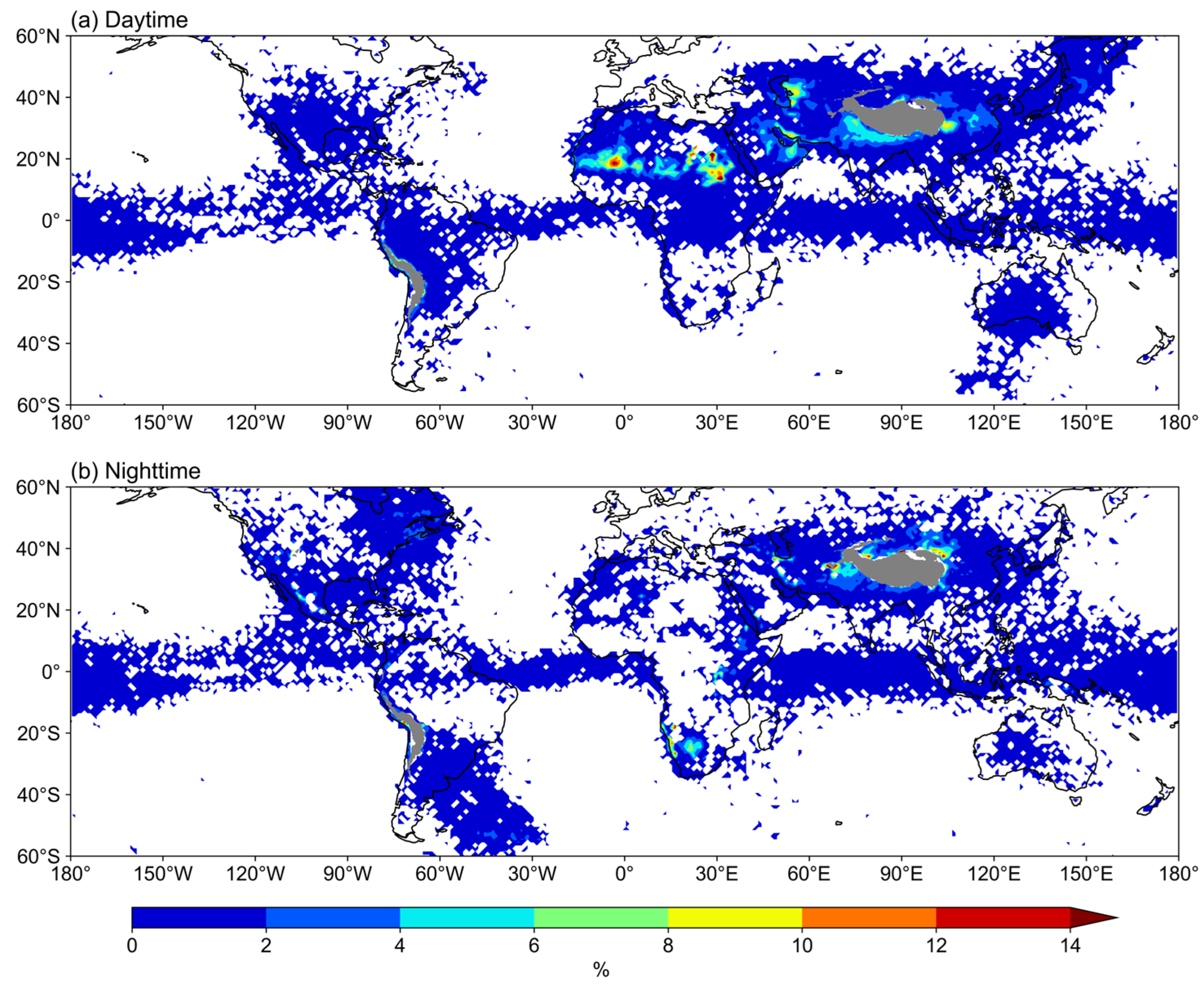
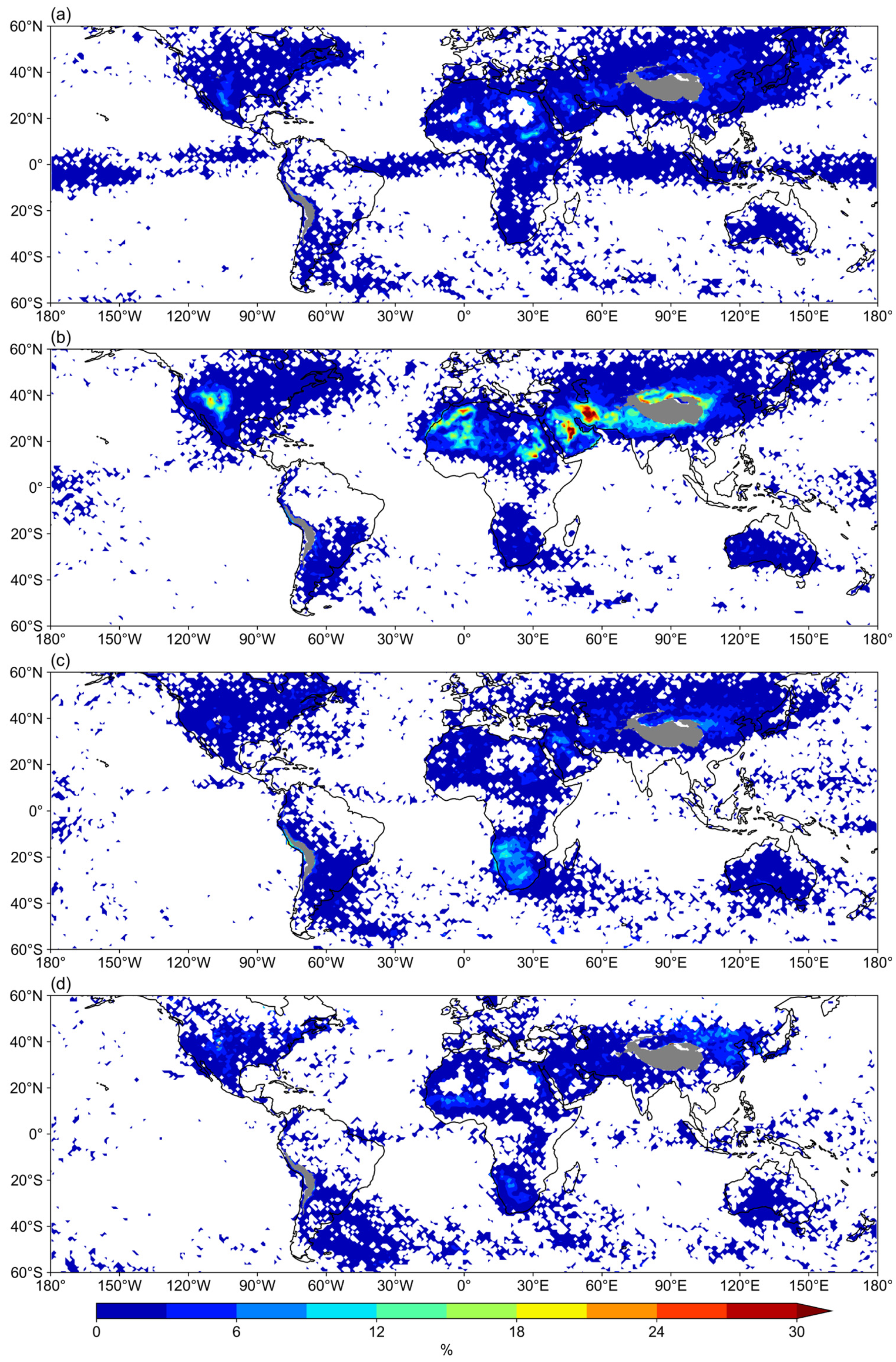
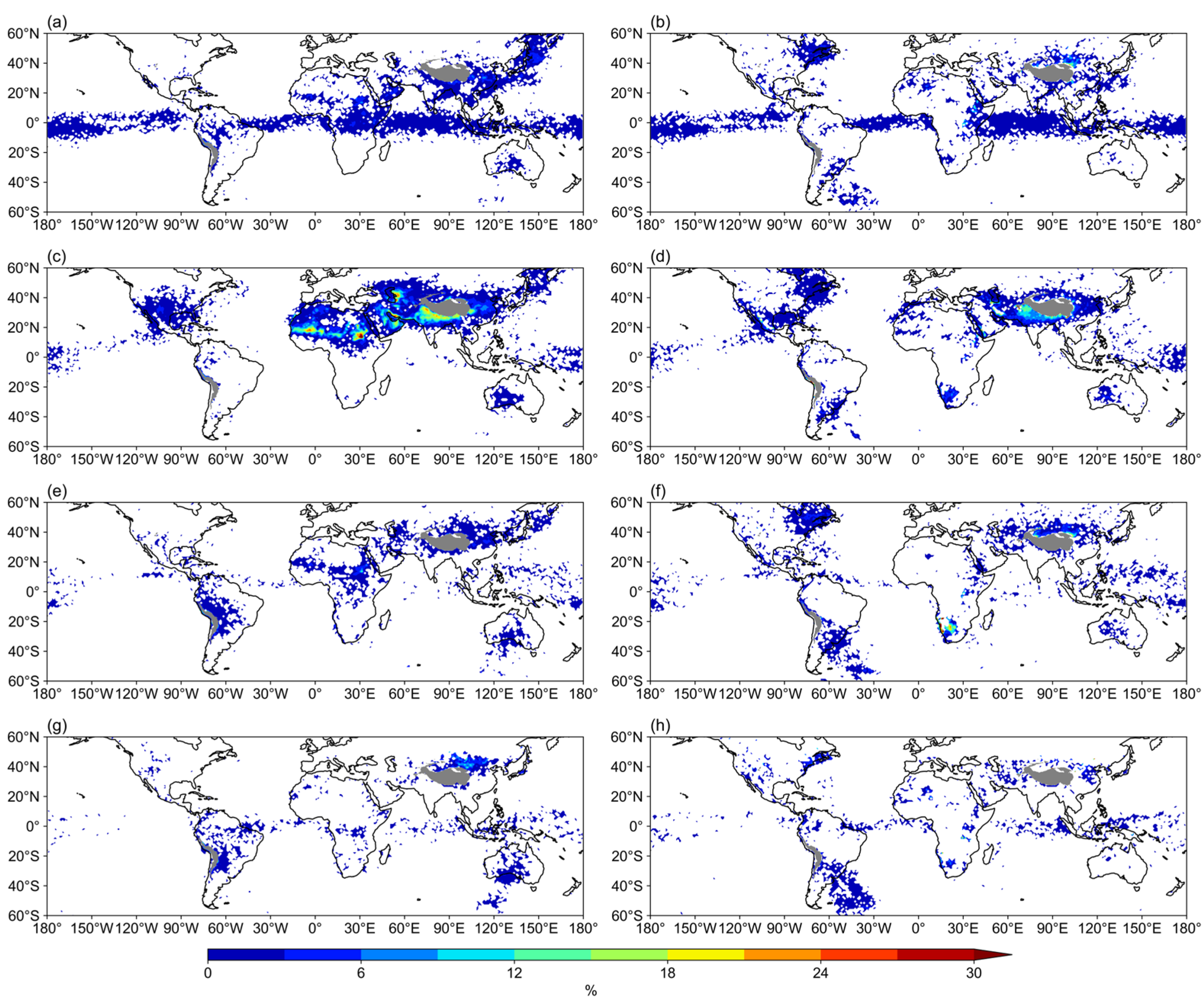
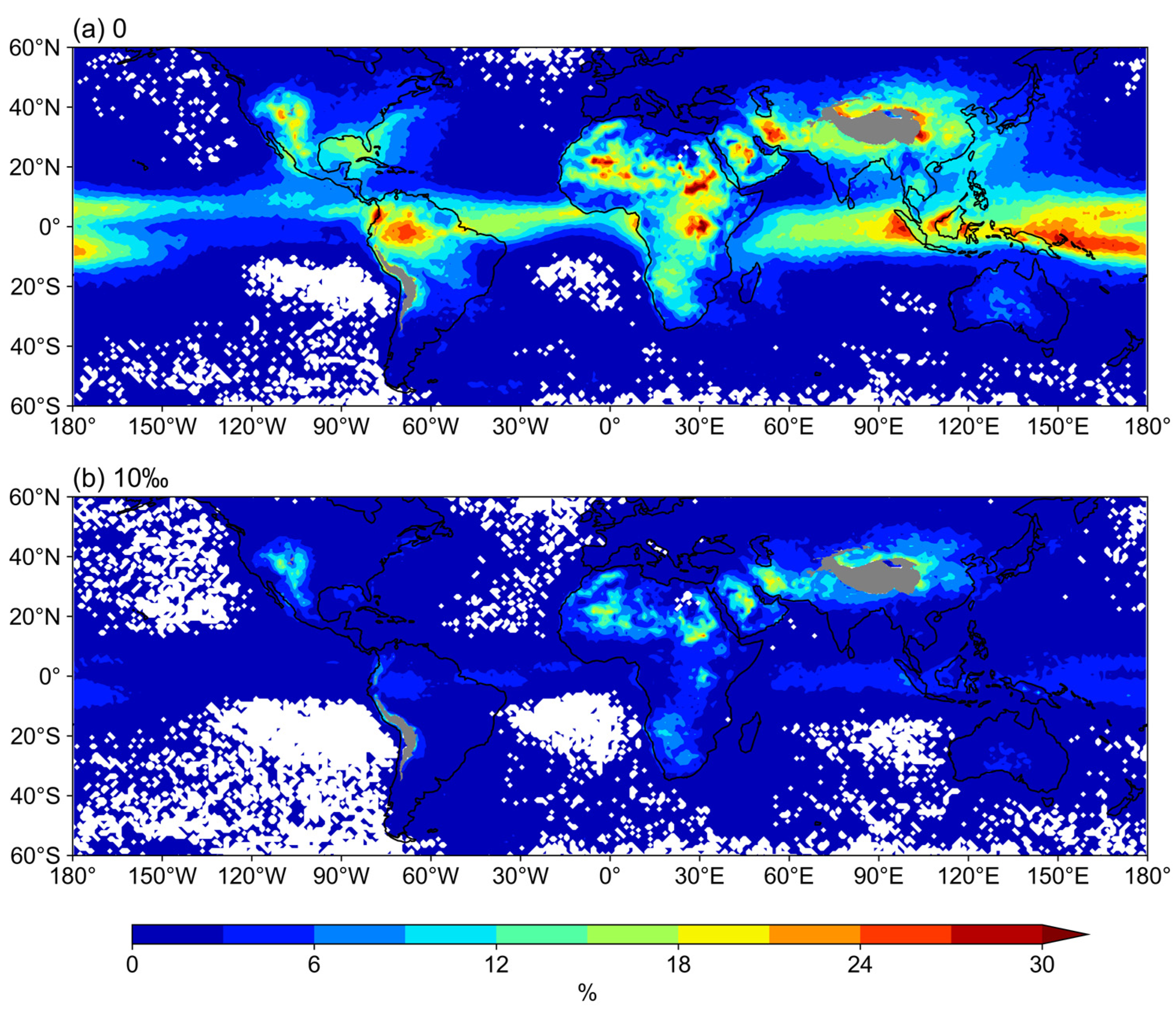

Disclaimer/Publisher’s Note: The statements, opinions and data contained in all publications are solely those of the individual author(s) and contributor(s) and not of MDPI and/or the editor(s). MDPI and/or the editor(s) disclaim responsibility for any injury to people or property resulting from any ideas, methods, instructions or products referred to in the content. |
© 2023 by the authors. Licensee MDPI, Basel, Switzerland. This article is an open access article distributed under the terms and conditions of the Creative Commons Attribution (CC BY) license (https://creativecommons.org/licenses/by/4.0/).
Share and Cite
Yang, G.; Xiao, Y.; Wang, S.; Qian, Y.; Li, H.; Zhang, M. Satellite-Based Distribution of Inverse Altitude Effect of Global Water Vapor Isotopes: Potential Influences on Isotopes in Climate Proxies. Remote Sens. 2023, 15, 4533. https://doi.org/10.3390/rs15184533
Yang G, Xiao Y, Wang S, Qian Y, Li H, Zhang M. Satellite-Based Distribution of Inverse Altitude Effect of Global Water Vapor Isotopes: Potential Influences on Isotopes in Climate Proxies. Remote Sensing. 2023; 15(18):4533. https://doi.org/10.3390/rs15184533
Chicago/Turabian StyleYang, Gahong, Yanqiong Xiao, Shengjie Wang, Yuqing Qian, Hongyang Li, and Mingjun Zhang. 2023. "Satellite-Based Distribution of Inverse Altitude Effect of Global Water Vapor Isotopes: Potential Influences on Isotopes in Climate Proxies" Remote Sensing 15, no. 18: 4533. https://doi.org/10.3390/rs15184533
APA StyleYang, G., Xiao, Y., Wang, S., Qian, Y., Li, H., & Zhang, M. (2023). Satellite-Based Distribution of Inverse Altitude Effect of Global Water Vapor Isotopes: Potential Influences on Isotopes in Climate Proxies. Remote Sensing, 15(18), 4533. https://doi.org/10.3390/rs15184533







